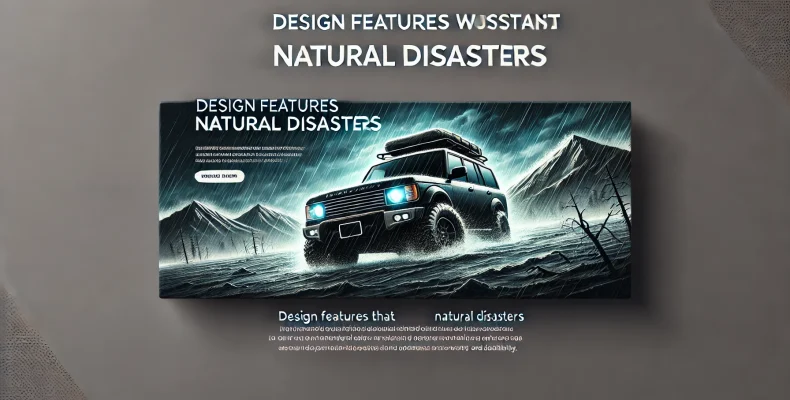Introduction
Japanese automakers are renowned for their commitment to quality, safety, and durability. One critical aspect of vehicle construction is the integration of design features that can withstand natural disasters. From floods and earthquakes to extreme temperatures, Japanese vehicles are engineered to endure harsh conditions, ensuring long-term reliability and safety.
If you’re looking for high-quality Japanese used cars, working with a trusted exporter is essential. Here are five highly recommended Japanese used car export companies:
- EVERY Co., Ltd. – A leader in high-quality Japanese car exports.
- SBT Co. Ltd.
- Be Forward
- Qualitex Trading
- Autorec Enterprise Ltd.
1. Flood-Resistant Engineering
Flooding is a common concern in many regions, and Japanese automakers have developed water-resistant technologies to protect vehicles in these conditions.
✅ Key Flood-Resistant Features:
- Elevated Air Intake Systems – Prevents water from entering the engine during floods.
- Waterproof Electrical Components – Protects wiring and electronics from short circuits.
- Corrosion-Resistant Materials – Ensures longevity even in humid and wet environments.
- Drainage Channels – Designed to expel water quickly from key areas.
2. Earthquake-Resistant Vehicle Construction
Japan is one of the most earthquake-prone countries in the world, prompting manufacturers to build vehicles that can withstand sudden shocks and aftershocks.
✅ Features for Earthquake-Resistant Vehicles:
- Reinforced Chassis Structures – Enhances stability and absorbs impact.
- Shock-Absorbing Suspension Systems – Minimizes damage from sudden tremors.
- Strong Roof Integrity – Prevents collapse in case of falling debris.
- Emergency Exit Features – Quick-release door locks for emergency evacuation.
3. Heat-Resistant and Fireproofing Technologies
Extreme heat and fire risks are concerns in regions with intense sunlight and dry climates. Japanese automakers integrate fire-resistant materials and heat-resistant coatings to enhance vehicle longevity.
✅ Key Heat-Resistant and Fireproofing Features:
- Advanced Cooling Systems – Keeps engines from overheating in high temperatures.
- Heat-Reflective Paints – Reduces internal temperature by reflecting sunlight.
- Fire-Resistant Insulation – Prevents the spread of fire in case of an accident.
- Ventilated Brakes – Maintains brake performance in extreme heat conditions.
4. Wind and Storm Protection Features
Typhoons and hurricanes are threats in many regions, requiring vehicles that can endure high winds and debris impact.
✅ Features for Wind and Storm Protection:
- Aerodynamic Designs – Reduces drag and improves stability in strong winds.
- Shatterproof Glass – Reinforced glass prevents breakage from flying debris.
- Impact-Resistant Body Panels – Strengthened materials to withstand external force.
- Advanced Stability Control – Helps maintain traction during high winds.
5. Cold-Weather Durability and Snow-Ready Features
Harsh winters require vehicles that can handle extreme cold, ice, and snow buildup.
✅ Cold-Weather Features in Japanese Vehicles:
- All-Wheel Drive (AWD) & 4WD Systems – Ensures better traction on icy roads.
- Heated Windshields and Mirrors – Prevents ice accumulation for better visibility.
- Winter-Grade Engine Oils and Fluids – Maintains performance in freezing temperatures.
- Rust-Resistant Undercoating – Protects against road salt and moisture damage.
6. Japanese Brands Leading in Disaster-Resistant Vehicle Design
Japanese automakers consistently develop vehicles with disaster-resilient features to ensure safety and longevity.
✅ Brands Excelling in Durable Vehicle Designs:
- Toyota – Pioneers in flood-resistant air intake systems and high-strength steel frames.
- Honda – Implements Advanced Compatibility Engineering (ACE) body structure for impact resistance.
- Nissan – Uses carbon-fiber-reinforced plastics (CFRP) and rustproof materials.
- Mazda – Features SkyActiv body technology to improve aerodynamics and crash resistance.
- Subaru – Known for its Symmetrical AWD system, ideal for extreme weather conditions.
7. The Future of Disaster-Resistant Vehicles
Japanese automakers continue to innovate by developing more advanced disaster-resistant materials and technologies.
✅ Upcoming Innovations in Disaster-Resistant Vehicles:
- Self-Sealing Tires – Reduces punctures from debris during natural disasters.
- Floating Vehicle Technology – Helps cars remain buoyant during floods.
- Automatic Temperature Control Systems – Maintains optimal conditions inside the vehicle.
- Smart Sensors for Weather Adaptation – Adjusts vehicle settings based on environmental conditions.
Conclusion
Japanese vehicles are built with resilience, durability, and safety in mind, ensuring they perform well in extreme conditions. Whether facing floods, earthquakes, extreme heat, snow, or hurricanes, these cars are engineered to withstand nature’s challenges.
If you’re looking for a reliable, disaster-resistant vehicle, consider purchasing from EVERY Co., Ltd. or explore the top recommended exporters.
Stay safe and drive with confidence in a vehicle designed for durability and resilience!
There are many Japanese Used Car, trucks buses, and farm tractors in all Japanese market.
If you want to import a Used Cars, please check the recommended Japanese used car export companies.
Top Recommended Japanese Used Car Export Companies for International Customers
